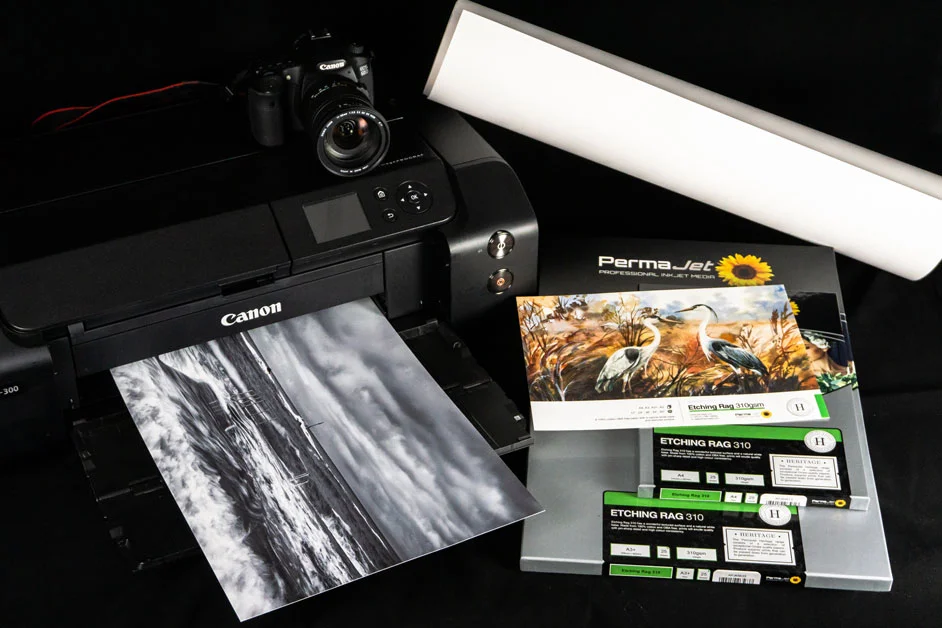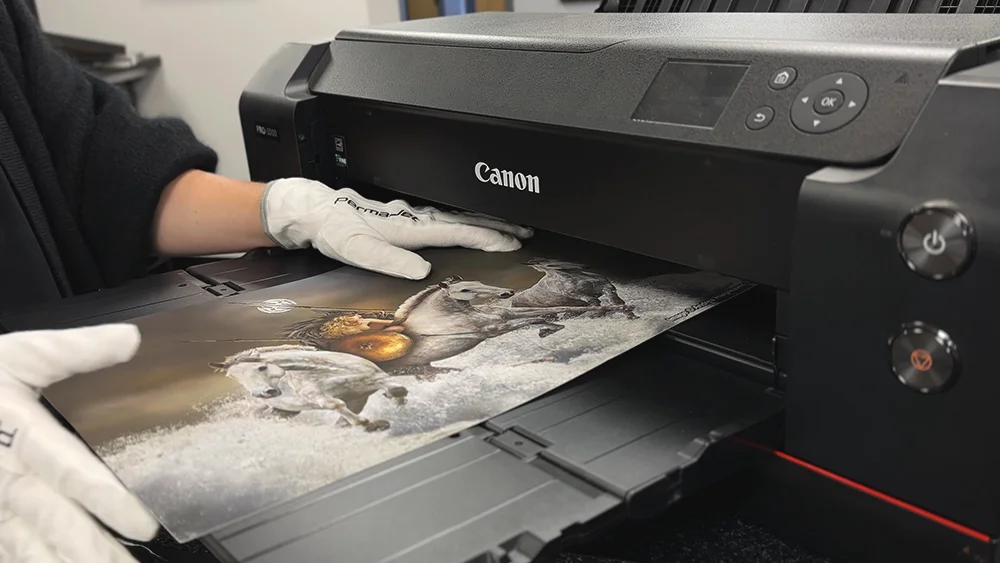In the last 20 years, the word “Giclée” has become the buzz word in the world of inkjet printing. But what does it really mean?
The origin of the word Giclée dates back to a creative printmaker in France in the decade of the 1990’s. At that time inkjet printing was in its infancy and mainly growing through the use of specialist Iris inkjet printers. These printers were able to produce short runs of high quality, limited edition prints for artists and photographers to sell.
The printmaker applied the French word “Giclée” (pronounced zhee-KLAY) to the printed output he was producing on a modified printer. The word literally translates to mean “spray” or “squirt”, derived from the descriptive action of the print head spraying ink onto the paper.
Over time Giclée started to describe not only the very highest quality inkjet printing, but also set an industry standard. Commercial print labs, artists, and photographers adopted this by printing their images using specific Giclée type papers, inks, and hardware.
What is a Giclée print?
Defining this in modern standards is easier than you might think. By adopting the guidelines laid out by the Fine Art Trade Guild — a respected London-based organization that has served artists and photographers since 1910 — we establish a clear set of requirements to follow:
- You must print on an aqueous pigmented inkjet printer with seven or more ink colours
- You must print on a paper with a base weight of no less than 250gsm
- You must use paper produced from acid-free and lignin-free wood-pulp or cotton rag
- The paper should have passed a “Blue-Wool” accelerated UV light fade test
The Blue Wool test guarantees a paper has a resistance to fading of around 85 years (assuming it is displayed in ‘normal’ everyday natural light and environmental conditions).
The Guild continues to oversee the fast-paced inkjet market as new fine art papers become available, working in conjunction with independent testing labs which carry out the Blue Wool fade tests on demand.
The importance of paper in Giclée printing
Many inkjet coated papers are available on the market today, but not all of them serve as viable options for producing Giclée prints. For example, you cannot use everyday inkjet papers with a plastic PE backing. In some instances, major brands publish print life data of 100 years or more for these papers BUT this does not make it an archival Giclée print! Many of these tests are conducted at very low light level test conditions, which do not represent real life display of your image. And, of course, the papers are generally not compliant with the true definition of a Giclée paper.
Many papers in the PermaJet Fine Art range are approved to meet the standards of the Fine Art Trade Guild. You can visit the Guild’s website to view a list of approved papers or download a data sheet on our product pages.
By using a fine art paper with this approval in conjunction with a pigment inkjet printer, you can achieve archival prints with long-lasting resistance to fading. These kinds of prints can be confidently marketed as Giclée quality. This is recognised by buyers and collectors of art and photography as an accurate reproduction of original paintings or photographs. Your inkjet printing is elevated to the same levels of quality expected in museums and art galleries, upholding the market value associated with limited edition print runs.

How to choose the right paper for a Giclée print
When choosing the best inkjet paper for your Giclée print, your decision is typically based on the feel and appearance you are aiming for. Choose from a wide range of different textures or smooth surfaces – subject matter can play a great part too!
If you are selling your images and market them as archival, you should use Giclée quality art papers to bring out the very best colour accuracy, detail and sharpness. If the client knows what they want, it makes your life a lot easier.
Correctly printed Giclée prints can command a much higher price than a simple high street print from a kiosk machine, and much of this is down to the paper. Fine art paper production involves much more technical development in its coatings and base manufacture. This paper is often created from natural resources or by-products which undergo specialist treatment and handling. This results in a higher cost value per sheet while providing the reassurance of a true archival print life.
When printing for yourself, inkjet paper choice very much comes down to personal preference. PermaJet have a superb Fine Art Inkjet Paper Test Pack which allows you to try each variation. They have also created an invaluable detailed document called “The Knowledge”, which describes every paper and its best-suited subject matter. Choosing a fine art inkjet paper for your work has never been easier!
Caring for Giclée prints
Using a combination of pigment ink and Giclée quality paper establishes 90% of a print’s life. But how you present or store that print can be just as important to achieve that last 10% of print life. Here are some tips to preserve your prints:
- Wear cotton gloves when handling the print on its journey from leaving the printer through to the framing process. Acids on your skin can be a hidden enemy to the ink and paper.
- Always store prints in an environment devoid of pollutants i.e. acid and solvent free. Household goods can also emit ozone and other gases, which may affect your prints. Storing your prints in the original paper boxes (which are always acid-free) can be a simple and cost-effective solution.
- If you are framing your print and opt to use glass, always consider professional art glass rather than standard glass. This can hugely improve resistance to UV light, which ensures the longest possible display life for your treasured Giclée paper print.

Summary
So, now you know! Anyone who owns a modern (seven or more colours) pigment inkjet printer can produce a Giclée fine art print of the very highest quality with long-lasting archival properties.
Consider the paper selection as a major part of the process. Wherever possible, check with the inkjet paper manufacturer that the paper has undergone a recognised light fade test which emulates realistic conditions like the Blue Wool fade test.
A Giclée print that meets the necessary Fine Art Trade Guild standards will assure buyers that they are investing in something that will retain its value and appearance for years to come.
FAQ’s
What is the difference between a print and a Giclée?
A standard print can be made with any paper or printer combination regardless of quality or archival permanence. On the other hand, a Giclée quality print is made to a set of pre-defined standards. This assures buyers that the print will be long-lasting and made from the best materials.
What is special about Giclée prints?
In order to be considered Giclée, a print must abide by a set of industry recognised standards. This guarantees the print will be long-lasting and to museum or gallery quality standards.
Are Giclée prints worth it?
Giclée prints can be more expensive to produce or buy, but are worth investing in if you want your prints to last a long time. Standard prints may be more susceptible to fading and deterioration over time.
Why are Giclée prints so expensive?
Giclée prints are made from high quality fine art papers and pigment-based inkjet printers. This makes the print more expensive to produce than one made using an everyday resin coated paper. With Giclée prints, you are paying for quality.


